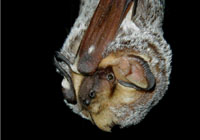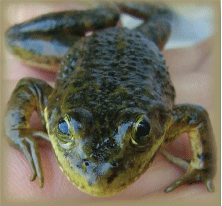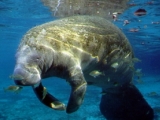- Home
- About S&T
- Taxa/Organisms
- Ecosystems
- Issues
- Methods & Tools
- Reports & Publications
- Location
- Search
Publisher: NBII | Format: URL
pollinators.nbii.gov — The global declines in many kinds of pollinator species could potentially impact the global food supply, as many plants depend upon specific pollinators to reproduce. The Web site of the NBII Pollinators Project provides access to information about the biology, ecology, conservation status, and threats to native pollinators, pollinator-dependent More...

Publisher: USGS | Format: URL
www.usgs.gov — It has been estimated that over 100,000 bats have died in the northeast due to a mysterious white fungus called White-Nose Syndrome (WNS). Scientists are finding within caves and mines a large number of bats with a white fungus on their muzzles and other parts of their bodies. It is uncertain as to how this fungus is being transmitted and its More...

Publisher: Other Federal Agency (United States Fish and Wildlife Service (USFWS)) | Format: URL
www.fws.gov — Tens of thousands of hibernating bats died this winter in the northeast, and for unknown reasons. In and around caves and mines in eastern and upstate New York, Vermont, western Massachusetts, and northwestern Connecticut, biologists found sick, dying and dead bats in unprecedented numbers. In just eight of the affected New York caves, mortality More...

Publisher: USGS | Science Center: Fort Collins Science Center (FORT, Ft. Collins) | Format: URL
www.fort.usgs.gov — This web resource links to materials related to the causes and consequences of bat fatalities. Videos of seasonal distribution and hydrogen isotope analysis are linked on the site, as well as other publications, articles and research on bat fatality.

Publisher: USGS | Science Center: Fort Collins Science Center (FORT, Ft. Collins) | Format: URL
www.fort.usgs.gov — Recent evidence shows that certain species of bats are particularly susceptible to mortality from wind turbines. Bats are beneficial consumers of harmful insect pests, and migratory species of bats cross international and interstate boundaries. Dead bats are turning up beneath wind turbines all over the world. Bat fatalities have now been More...

Publisher: USGS | Science Center: Fort Collins Science Center (FORT, Ft. Collins) | Format: URL
www.fort.usgs.gov — The dynamics of rabies transmission in bat populations that roost and live within cities is being investigated using Fort Collins, Colo., and big brown bats (Eptesicus fuscus) as the case study. USGS biologists are working on this project in collaboration with Colorado State University, the Centers for Disease Control and Prevention, and the More...

Publisher: USGS | Science Center: Fort Collins Science Center (FORT, Ft. Collins) | Format: URL
www.fort.usgs.gov — During the winter of 2006 or 2007, an affliction of unknown origin dubbed "White-Nose Syndrome" (WNS) began devastating colonies of hibernating bats in a small area around Albany, New York. Colonies of hibernating bats were reduced 81-97 percent at the affected caves and mines that were surveyed. Since then, White-Nose Syndrome has been detected More...

Publisher: USGS | Science Center: Forest and Rangeland Ecosystem Science Center (FRESC, Corvallis) | Format: URL
fresc.usgs.gov — The Conservation Genetics Lab carries out molecular analysis, pedigree analysis, modeling, data management, and cryogenic sample repository. As a part of this research, the lab investigates the effectiveness of molecular markers used to enhance enforcement of the Endangered Species Act policy. During the past 15 years, this research has involved More...

Publisher: USGS | Science Center: Western Ecological Research Center (WERC, Sacramento) | Format: URL
www.werc.usgs.gov — This site is a summary of bat research efforts by the USGS Western Ecological Research Center. From the site: "Scientists at the USGS Western Ecological Research Center are studying bats in the San Francisco Bay area and in southern California to provide land managers information they need regarding the occurrence and status of bat species." More...

Publisher: USGS | Science Center: Fort Collins Science Center (FORT, Ft. Collins) | Format: URL
www.fort.usgs.gov — How do you study something that flies under cover of darkness? This question persistently troubles scientists investigating the mysterious lives of bats. The 45 bat species that occur in the continental United States play important roles in U.S. ecosystems as major predators of flying insects and pollinators of desert plants. Bats also play an More...

Publisher: USGS | Science Center: Biological Informatics | Format: URL
biology.usgs.gov — This web page presents samples of genetics and genomics research from the USGS Biological Resources Discipline about the conservation genetics of mammals.

Publisher: USGS | Science Center: National Wildlife Health Center (NWHC, Madison) | Format: URL
www.nwhc.usgs.gov — The condition in bats known as "white-nose syndrome" (WNS) was first noted among dead and hibernating bats found in caves near Albany, New York, by the New York State Department of Environmental Conservation beginning in February 2007. Affected bats appeared to have a white substance on their heads and wings. In early 2008, "white-nosed" bats were More...
